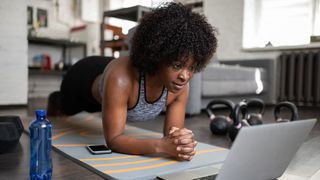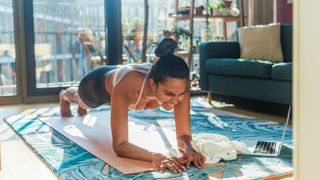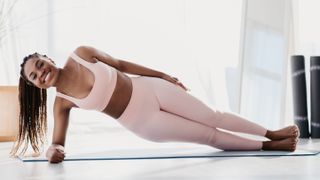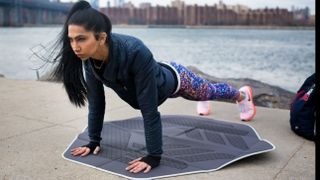Plank exercise: How to correctly perform the move and variations to try
A physical therapist explains the benefits of the plank exercise as well as challenging plank variations to try

There’s a good chance you’ve heard of the plank exercise if you have spent time working out at the gym, or perused fitness magazines or online articles. You may even have gotten down on one of the best yoga mats and tried this popular core exercise at one point or another.
For regular gym goers, athletes, and fitness enthusiasts, the basic plank exercise – or more advanced plank variations – are among the mainstays of most workout routines.
This core exercise is ubiquitous for a reason: it works. There are also many ways to modify a plank, depending on your strength and goals, which means that it’s a bodyweight exercise that can “grow” with your fitness level.
To learn more about how to properly perform a plank and the best plank variations to try, we spoke with Kristina Kehoe, a physical therapist, Registered Yoga Teacher, and the Owner of Simpli Whole, a physical therapy practice.

Kristina Kehoe gained her doctorate in physical therapy in 2015 from the Ohio State University. She is the owner of Simple Whole, a physical therapy practice located in Ohio.
What is a plank?
Most people have heard of the plank exercise, but there are also plenty of misconceptions about what this move entails.
Although there are lots of variations and modifications, a plank is an isometric exercise that targets the core – so if you’ve ever wanted to know how to get a stronger core, you’ll find the plank figures highly.
“A plank typically involves assuming a push-up type position and maintaining that position for a specific amount of time,” explains Kehoe. “There are a variety of variations of the plank that can target different areas of the core.”
The basic forearm plank is performed with your body propped up from your elbows with your forearms and toes on the ground.
The different plank variations may recruit additional muscles or add forms of resistance, instability, or movement to progress or regress a basic plank.
What muscles do planks strengthen?

Kehoe says that the primary muscles activated during the plank exercise are those that make up the core, such as the transverse abdominis, the rectus abdominis, and the internal and external obliques.
“The transverse abdominis is our deepest core muscle. This muscle acts as a corset and attaches to our pelvis then wrapping around our front to the lumbar spine. It helps stabilize the spine in all movements,” explains Kehoe. “The rectus abdominis is the ‘6-pack’ abs that run on the front part of our abdomen. The obliques run on the sides of our abdomen and help in overall stability.”
In addition to these abdominal muscles, planks activate other muscles of the core such as the erector spinae in the lower back, the serratus anterior in the upper back, the latissimus doors, and the glutes. Most plank exercise variations also engage the deltoids in the shoulders and pectoralis major and minor in the chest.
Why is the plank a good core exercise?
Personal trainers, strength and conditioning specialists, and sports coaches around the world use the plank as a go-to exercise for their athletes. But why are planks such a popular core exercise? What makes a plank more effective than crunches or old-school sit-ups? And why are core muscles important?
According to Kehoe, one of the primary benefits of the plank as a core exercise lies in its safety.
“The plank is an effective exercise because it doesn’t put a lot of compressive force on the lumbar spine like exercises such as full-sit ups or back extensions. Therefore, it’s a safer option especially if you’ve had a recent back injury,” she notes.
“Additionally, the plank exercise and variations have been shown to improve core muscle endurance as well as stability and are effective in improving overall core strength in pre- and post-testing with the McGill Torso Muscular Endurance Test.”
Kehoe adds that other benefits of the plank as a core exercise is that it’s a bodyweight exercise that does not require equipment and it can be modified to target different muscles or fitness levels. “There are a number of ways to progress planks to decreasing support on a surface, adding an unstable surface, or adding dynamic movement,” she says.
How to Perform a Basic Plank
Before we delve into some more advanced variations, let’s review how to perform the basic plank exercise. A plank can be performed on your hands so that you’re in a push-up position, or on your forearms.
Forearm plank

- Get down on all fours. Bend your arms to support your weight on your forearms. Your elbows should be directly underneath your shoulders.
- Step both legs back, so only your forearms and toes are touching the ground. Your feet should be hip-width apart.
- Squeeze your glutes and engage your abs by drawing your belly button up to your spine. Your body should be in a straight line from your head to your feet. Kehoe says, “Imagine drawing the kneecaps up to engage the quadriceps muscles.”
- Hold for 30 to 60 seconds.
Plank variations to try
After you’ve mastered the basic forearm plank, you can progress your core strength with more advanced plank variations. Kehoe walked us through a few of her favorite plank variations:
Side plank
The side plank targets your obliques, the muscles on the side of your abs, and your gluteus medius, a key hip abductor muscle. It’s also slightly more challenging than a standard plank because you are decreasing your base of support from two arms and two feet to one arm and one foot.
Kehoe offers some form tips. Avoid sinking into your shoulder and imagine pressing up through your elbow and forearm for stability. "This will limit unnecessary strain on your shoulder,” she advises. “Don’t allow your hips to dip and maintain an even position so you get the most activation of your core muscles.”

- Lie on your side with your legs stacked on top of each other.
- Push up and straighten the arm on the side of your body that is resting on the ground so that your whole body lifts up into the air. Your arm remains straight, your legs remain straight, and your feet stay stacked one on top of the other.
- Concentrate on pushing your top hip up to the ceiling.
- Hold this position for 30 seconds, or stop early if your form waivers.
Side plank with reach through
This plank modification further progresses the side plank by adding rotational movement, which Kehoe says is great for improving functional core strength for sports like golf and tennis. Her advice is, “Only reach as far as you can while still maintaining a stable side plank and increase this as you feel stronger.”

- Lie on one side with your elbow stacked under your shoulder and feet stacked on top of one another.
- Lift your hips off the ground and extend your top arm up straight up towards the ceiling. You should be in a side plank position.
- Slowly rotate your pelvis towards the floor while reaching your extended arm underneath your body to tap your shoulder blade.
- While maintaining your balance, rotate back to the starting position.
- Complete 12-15 slow reps and then switch sides.
Plank hip dips
Kehoe says you should perform this exercise slowly to really activate your oblique muscles and imagine pressing the mat away with your forearms to avoid sinking into your shoulders.

- Do a side plank, as above, with your legs stacked on top of each other and your elbow under your shoulder for support
- From here, drop your hips towards the floor with control and then raise them back up in line with your body.
- Keep your core tight and engaged throughout the movement.
High plank mountain climbers
In addition to adding an aerobic component to the isometric plank, which will elevate your heart rate and calorie burn, the plank with mountain climbers will really target the front of the core (the rectus abdominis muscle).

- Get into a push-up position with your core and glutes engaged and your hands placed on either side of top of the medicine ball, which should be centered under your chest, or you can put them on the floor if you are less confident in your core strength.
- Pressing your weight into your hands, alternate bending each knee and bringing the leg up under your chest between your arms and then returning it to the starting position.
- Move as fast and hard as you can for 30-60 seconds and progress to longer durations as you get stronger.
Plank jacks
According to Kehoe, “Plank jacks will help increase the heart rate to add more of a dynamic movement to a typically isometric exercise. It will help burn more calories while targeting the outer and inner thighs as well.”

- Get in a push-up position.
- Maintaining a tight core and good form, splay your legs as you jump them out to their respective sides away from your body, about the width of a yoga mat.
- Jump them back in and out rapidly and repetitively, keeping your hips down so that you’re still in a straight line from your head to your feet.
Sign up for the Live Science daily newsletter now
Get the world’s most fascinating discoveries delivered straight to your inbox.
Amber Sayer is a fitness, nutrition, and wellness writer and editor, and contributes to several fitness, health, and running websites and publications. She holds two masters degrees—one in exercise science and one in prosthetics and orthotics. As a certified personal trainer and running coach for 12 years, Amber enjoys staying active and helping others do so as well. In her free time, Amber likes running, cycling, cooking, spending time outside, and tackling any type of puzzle.

